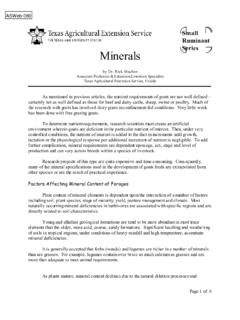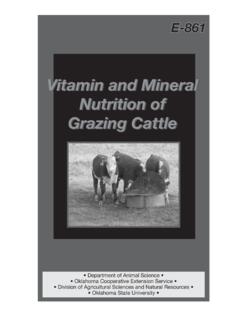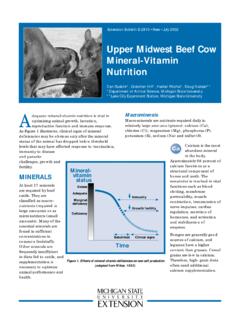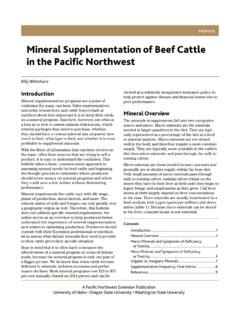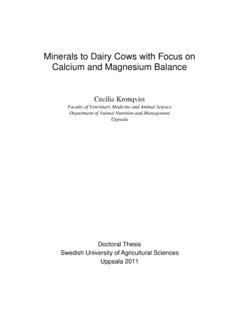Transcription of Winter Mineral Nutrition for Beef Cows - seaagri.com
1 Winter Mineral Nutrition for beef cows Adele Harty 11/25/2012. Winter supplementation often focuses heavily on meeting protein and energy requirements of cows and tends to leave Mineral Nutrition as almost an afterthought. In reality, meeting all nutrient requirements, including energy, protein, minerals, vitamins, and water are equally important. Missing the mark in any of these five nutrient categories can have equally negative effects. In reality, all nutrients interact, and deficiencies in Mineral Nutrition can create deficiencies in availability of other nutrients, even if those nutrients are adequate in the diet. During Winter months, locally grown forages are typically the basis of cattle diets, and important considerations are the amount and availability of minerals in forages.
2 Due to the drought, this year may be a very different situation with hay coming from different areas in the state or country. The amount of each Mineral in the forage is based on Mineral content of the soils they are grown on, which is highly variable because of variation in the geologic parent material the soils come from. Not only does this affect Mineral status from one region to another, but it can be highly variable on a local basis, to the point that Mineral content of forages can vary from one pasture to the next. Additionally, Mineral content and availability are not the same thing, with Mineral interactions playing a key role. Another key characteristic of forages that drives Mineral availability is digestibility.
3 Higher quality forages that have higher digestibility will have greater availability of the minerals they contain than mature forages such as dormant Winter range, crop residues, or CRP hay. Due to drought conditions and ranchers having to utilize alternative forages, the Mineral program that has worked in the past may not meet the Mineral requirements of the animals this year. With forage sources coming from different areas, the forages, protein supplements, and water need to be sampled and tested for Mineral content, then compare the Mineral supply to livestock requirements, and formulate a supplement to overcome specific deficiencies and interactions. Additional feed and water testing and monitoring of animal responses are needed to fine-tune the formulation.
4 While this involves a considerable amount of up-front effort and expense to sample and measure Mineral content, it has several potential advantages, including improved cattle performance, reduced Mineral costs by avoidance of excess Mineral feeding, prevention of interactions/antagonisms, and prevention of toxicity. The protein supplement has to be evaluated for Mineral content as well. One protein supplement available and frequently used in South Dakota is distiller's grains. This can provide some new challenges in Mineral supplementation as distiller's grains are high in phosphorus and sulfur. In general, Mineral Nutrition is challenging as minerals can interact with each other and can be antagonistic, meaning that they can bind with each other and reduce availability to the animal.
5 In other words, sometimes an excess of one Mineral has to be fed in order to overcome an antagonism. Secondly, excess minerals can cause toxicity and potentially death, therefore to overcome the antagonisms it is critical that minerals are not supplemented needlessly because of cost and toxicity concerns. In general, if distiller's grains are being fed as the protein supplement, make sure the Mineral supplement does not contain phosphorus or sulfur, but does contain additional calcium and copper. When speaking of forage Mineral levels, typically calcium levels are adequate in forages and phosphorous levels tend to be low and often inadequate, especially in mature forages. Thus, phosphorous supplementation is often necessary, especially with low quality forages such as Winter range, crop residues, or low quality hay.
6 The specifics of the Mineral program can vary greatly depending on the total ration Mineral composition. Some basic recommendations for Winter Mineral supplementation programs are: Always provide trace mineralized salt as a minimum. Supplement phosphorous when forage is dormant unless distiller's grain is being used as a protein source. Supplement copper if symptoms are present, but be sure to monitor copper status to ensure deficiency is solved without reaching toxic levels. Because off-the-shelf Mineral and salt products are formulated to meet generalized conditions, it is often beneficial to create a custom-blended Mineral formula to meet localized deficiencies or toxicities of a specific ranch.
7 Minerals are important nutrients that need to be properly balanced in the diet. If dietary feedstuffs do not contain adequate minerals or contain an imbalance, then Mineral supplementation is necessary. This is usually the case. However, Mineral supplements are often expensive and careful attention to providing the right supplement can be key to ensuring that we get the biggest bang for the buck. This article was written with contributions from Ken Olson, SDSU Extension beef Specialist. - See more at: #sthash. SEA-90 Essential Mineral - 90 Minerals and Trace Elements Including Copper

